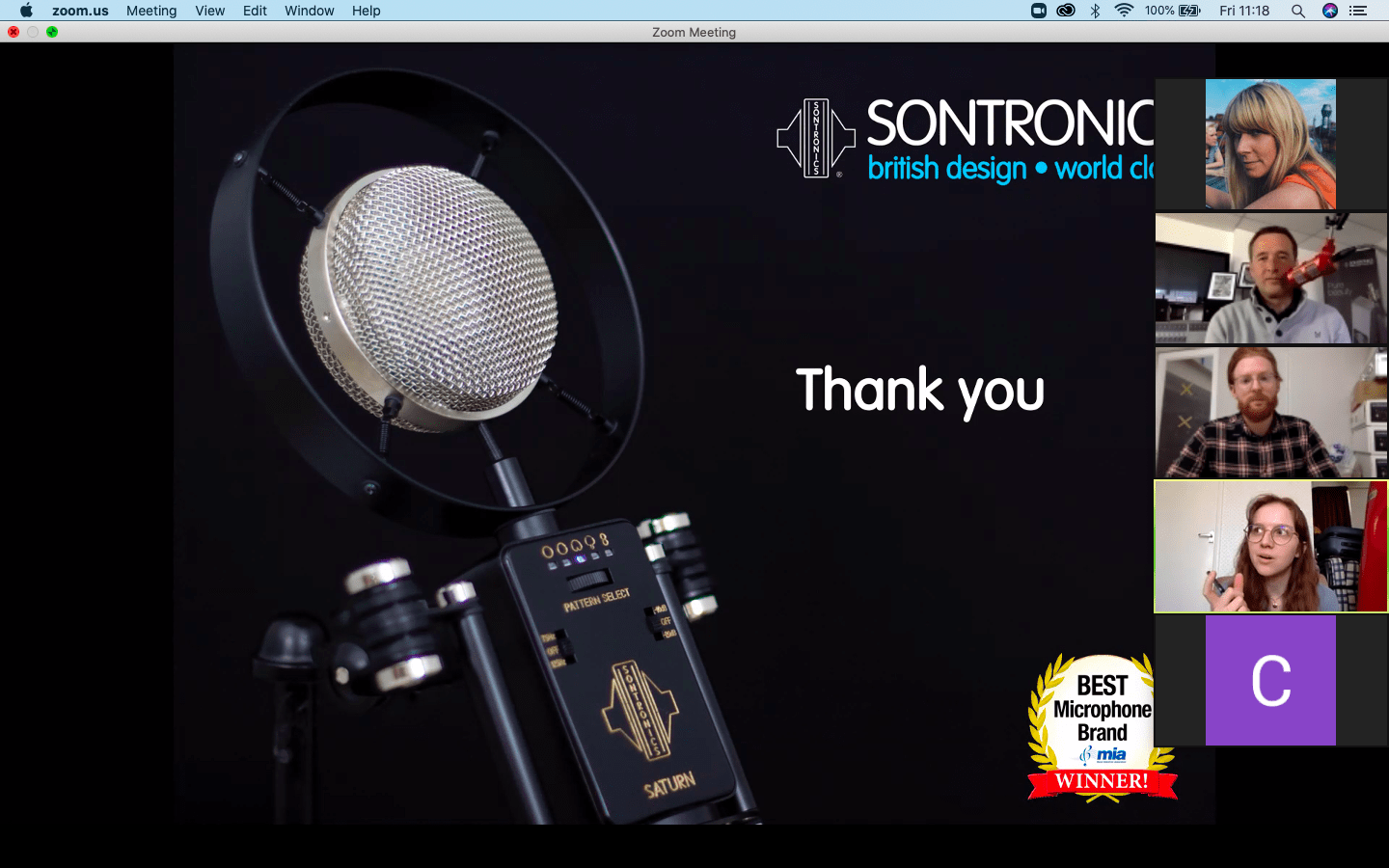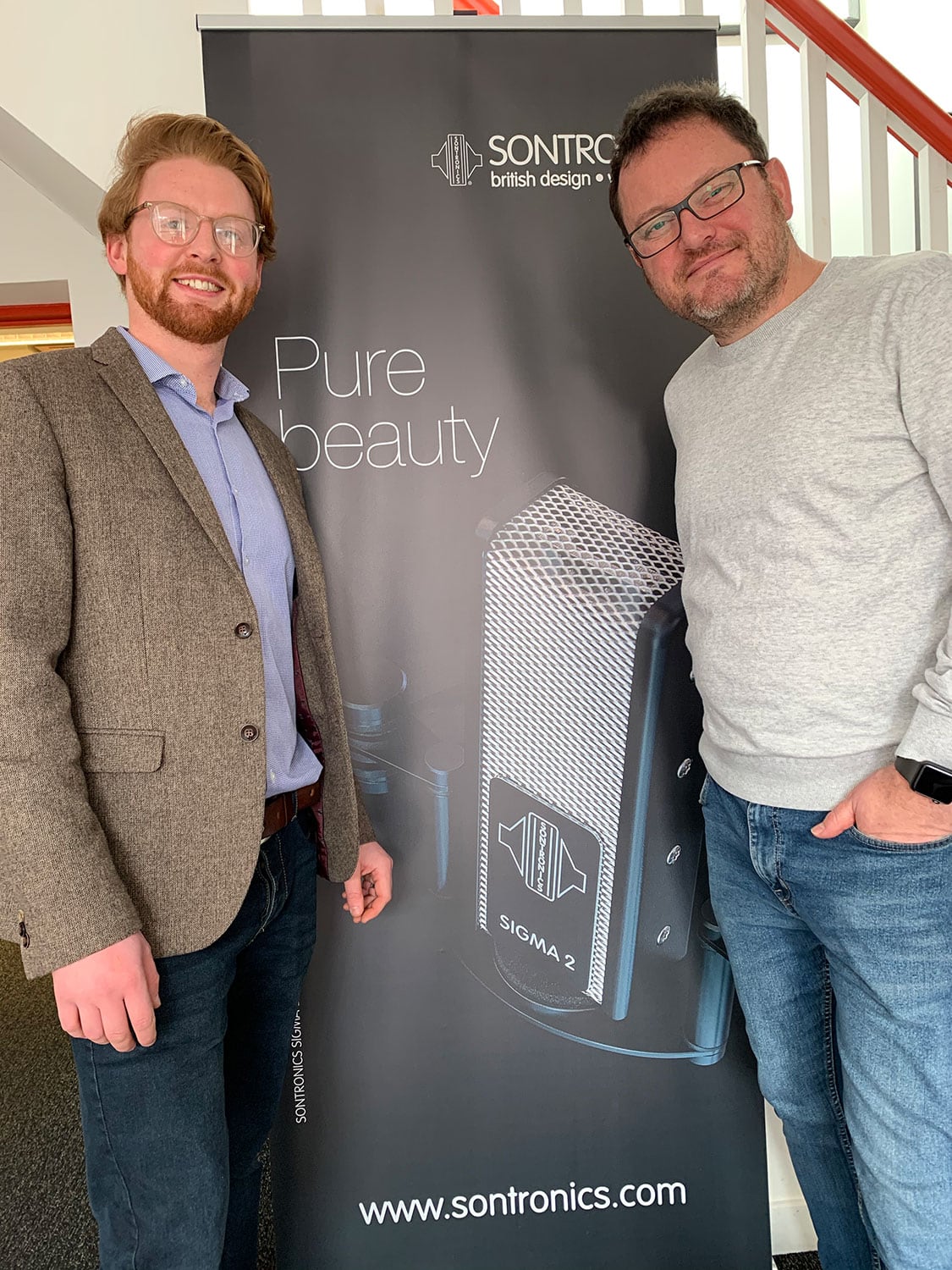Microphone Models and Studio Set Up with Sontronics
There are myriad choices to consider when you are planning and setting up for a recording session. One key area that always generates much debate and discussion, is microphone selection and placement. Those decisions you make prior to recording that ensure you capture the sound both you and the artist you’re recording are aiming for.
Being able to understand and make informed choices on microphone selection for specific applications, argue the importance of microphone directionality and interpret measurements and specifications are just some of the skills our students learn. They need to be confident in making informed choices about standard stereo microphone techniques with varying microphone types, spaces and angles. All of this knowledge ensures they can set up, navigate and thrive in any session from 100+ piece symphonic orchestras or a band with full backline and percussion to a string quartet, solo vocalist or any other possible combination of musicians you can imagine in the studio.
Here at Abbey Road Institute London, our students have access to some of the best recording equipment available, including a wide variety of renowned high-quality microphones. This enables them to learn the nuances of different models and help them define their own recording style and sound.
Our stock includes a range of mics from Sontronics which have been used regularly for class recordings and by our students for their productions. Trevor Coley, Sontronics’ founder, regularly gives microphone lectures taking our students through the history of microphone innovation and design and the unique aspects of different microphone models.
Recently we formalised our partnership with Sontronics, with a workshop different to any others they’ve given before. With the lockdown in place in the UK, Trevor applied his creativity and gave his first online workshop via Zoom. Here we share some of the experiences from a workshop in our studio earlier this year and the recent online Zoom workshop.

Which microphone, why and where?
Back in February, prior to lockdown, Trevor delivered both a classroom-based lecture and a practical recording workshop in our studio with our students. The session opened with an introduction to Sontronics, their vision and the journey to where the company is today. This included looking at how and why their mics differ in design and construction and what applications they are best suited to for recording. The subject areas of electronics, physics and acoustics were explored to help our students understand what gives a microphone it’s unique sonic characteristic.
Working in our Custom 75 studio, the class was split into two groups creating two bands. The first class recorded a track by up and coming self-producing artist Johnny Jacobson. Accompanied by classmates Giacomo on guitar, Martin on drums and Forbes on piano, they captured a live recording of one of Johnny’s new songs. The second class saw students Alice (Drums), Nick (Vocals), Bruno (Bass), Rapha (Guitar) record a soulful interpretation of “Ain’t No Sunshine” by Bill Withers.
The following mics were used in the workshop:
- Kick – DM-1B & Podcast Pro Mic (dynamic)
- Snare – DM-1S (condenser)
- Toms – 3 x DM-1T (condenser)
- Drum overheads – Orpheus (condenser)
- Upright Acoustic Piano – Apollo 2 (condenser)
- Electric Guitar – Halo & Delta 2 (condenser)
- Bass Guitar Cabinet – DM-1B & Podcast Pro (dynamic)
- Vocals – Solo (dynamic)
Whilst inside the live room, Chris Cook, Sontronics product manager and Abbey Road Institute alumnus, experimented with different mic positions and techniques while Trevor discussed the results with the class in the control room explaining why little to no EQ may be required if you use the appropriate mic in the correct position. Once the band had their takes down they then came back into the control room to hear the results for themselves.
Student Jean-Francois shared his experiences of the workshop:
“Trevor, Lisa and Chris have a genuine passion for what they do and take a real interest in every student’s journey. I use the Drumset in my studio and, after hearing Chris recording saxophone with a pair of Delta 2 condenser powered ribbon mics, was won over by their beautiful, precise yet soft sound. Really great results without even having to think too much about EQ.”
Trevor enjoyed the workshop as much as our students:
“They all showed so much enthusiasm and engagement during our workshop, and the standard of their musicianship was simply superb. It’s always great when everyone is fully committed to these sessions – it creates a real vibe and reminds us all that making music together can be such an incredible thing.
The students seemed to enjoy themselves so much that they didn’t want the day to end – quite frankly, neither did we!”

To Zoom and beyond
Moving now to where we are today during a time in which our students are working hard at home and receiving their lectures online until the lockdown is lifted and we get back into our studio. We’ve had many great experiences over the past couple of months with guest speakers including engineer and producer Haydn Bendall, producer Peter Walsh and more recently our colleagues from Abbey Road, engineer Paul Pritchard and Head of Audio Products Mirek Stiles.
We were therefore thrilled when Trevor offered to talk remotely via Zoom about the history of microphone design and development, and the classics that have inspired his designs. During his online workshop, Trevor covered various microphone-related topics with a focus on selecting the correct microphone for any given source. He drew attention to the need to consider the fundamental and harmonic frequencies of an instrument, or voice, and how to choose a microphone which best reproduces those frequencies.
Trevor draws parallels between microphone design and the music production process: “In a similar way to how an artist should try to find their own style and voice rather than copy another, we’re not in the business of trying to replicate legendary mics such as a Neumann’s U47. While we learn and take inspiration from the classics we always strive to create something unique, exciting and usable. We are proud that many professionals now consider mics from our range to be modern classics.”
Student Stella Massonnet shared her thoughts with us about the Sontronics online workshop: “The Sontronics introduction was my first insight from a manufacturer’s perspective into to how microphones are made and how varied they could be. It was fascinating.’

Part of the team
We are incredibly proud of alumnus Chris Cook who now works for Sontronics as Education Coordinator and Product Manager. Chris graduated from Abbey Road Institute in 2016 but his first experience with Sontronics mics happened just after he finished his music degree at Brunel University where he purchased a pair of STC-1’s.
“When buying my first mics, I noticed that Sontronics were based close to where I lived so I approached them to see if there were any job opportunities. While there was nothing suitable at the time, I kept in touch with Trevor and Lisa who were excited to hear that Abbey Road had launched an Institute as they had been getting development feedback form Abbey Road’s microphone technician Lester Smith.”
After graduating, Chris started interning with Sontronics two days a week and commuted to London to work as a part time technician here at the Institute. His career is very much going from strength to strength and it’s great we still have such regular contact through his role at Sontronics. Chris told us: “As a graduate, it is rewarding to now be in a position to help the Institutes’ next generation of producers and engineers further develop their recording knowledge and skills.”

Looking to the future
We are all looking forward to returning to the Institute over the coming weeks. And, while we may well be delivering classroom lectures online for a while to come, we hope to welcome Trevor, Lisa and Chris back to the Institute to run their mic workshop again later this year.
Campus Manager Mike Sinnott commented:
“As well as making great-sounding mics, Trevor and his team have always provided the Institute and our students a high level of personalised support. We are pleased to count Sontronics as one of our official industry partners and look forward to working closely with Trevor, Lisa and their team as we plan to expand our facilities.”
Visit our location page to learn more about the mic collection and other equipment you have access to as a student at the Institute.

